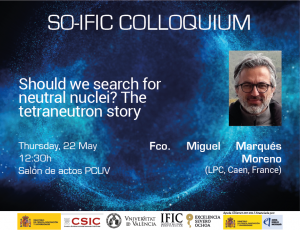Do nuclei formed solely by neutrons exist? One of the greatest enigmas of nuclear physics will be the topic of the next SO-IFIC colloquium.
In 1911, Rutherford discovered the atomic nucleus, and in 1919 he demonstrated that the proton, the nucleus of hydrogen, was the carrier of its positive charge and a fundamental component of all heavier nuclei. Finally, in 1932, the other essential component was found: the neutron, which acts as a nuclear glue that keeps heavy nuclei together against Coulomb repulsion. Soon, a natural question arose: could this glue form neutral nuclei on its own? The search for these multineutrons began in the 1960s, when techniques to study them became available. By 2002, this search had already been ongoing for 40 years without success and was declining, but then a first positive signal consistent with a tetraneutron was observed at the Grand Accélérateur National d'Ions Lourds (GANIL), or Large National Heavy Ion Accelerator.
This will be the topic of the next Severo Ochoa colloquium offered by the Instituto de Física Corpuscular (IFIC), a joint center of CSIC and UV, under the title: “Should We Search for Neutral Nuclei? The History of the Tetraneutron,” presented by Fco. Miguel Marqués Moreno, a researcher at the French National Center for Scientific Research (CNRS), where he is a research director at the LPC (Laboratory of Corpuscular Physics) in Caen. The event will take place in the Auditorium of the Head Building at the Scientific Park on May 22 at 12:30 pm.
This result obtained at GANIL shook the scientific community on several levels. The importance of its potential consequences led it to the media, in more or less reliable forms. However, theory could not explain the existence of a tetraneutron. Some colleagues, both theorists and experimentalists, did not believe that this signal was significant enough. Everyone was waiting for a more solid confirmation or eventually a refutation. However, in the following years, nothing happened—at least nothing that fit the refined format of standard scientific publications. And yet, many things did happen! But most had little to do with physics, and those that did did not follow the linear success story often found in physics books and journals.
During the talk, Marqués will use this first 4n signal to discuss various aspects of basic research. How does it work or how should it work? Why should we look for things that are not supposed to exist? Should we plan our search for the unknown? How should we communicate experimental failures? Should we allow them? How should we interact with the media? We will also review the present and future of this line of research. In 2016, something else happened: a new, albeit weak, "tetraneutron" signal was reported at RIKEN, and a recent article in Nature showed a strong confirmation of a "correlated 4n signal," not of a tetraneutron. Is it just a semantic issue? Why does this word matter so much?
Fco. Miguel Marqués Moreno holds a Ph.D. in Nuclear Physics from the University of Valencia. Since 1995, he has worked for the French CNRS, where he is a research director at the LPC (Laboratory of Corpuscular Physics) in Caen. His research area focuses on the study of atomic nuclei with an excess of neutrons, particularly specializing in "neutral nuclei," systems formed solely by neutrons. He has published more than 100 articles in international journals and led several projects at the GANIL (France) and RIKEN (Japan) particle accelerators. He also actively participates in knowledge dissemination through numerous talks and the editing and publication of books. He has directed the Joliot-Curie International School of Nuclear Physics and is currently an editor of the international journal Few-Body Systems.
This will be a great opportunity for attendees to learn about the next steps in a still-open field. The event will also be accessible online. More information can be found here.
This colloquium is part of the CEX2023-001292-S grant funded by MICIU/AEI/10.13039/501100011033/




















